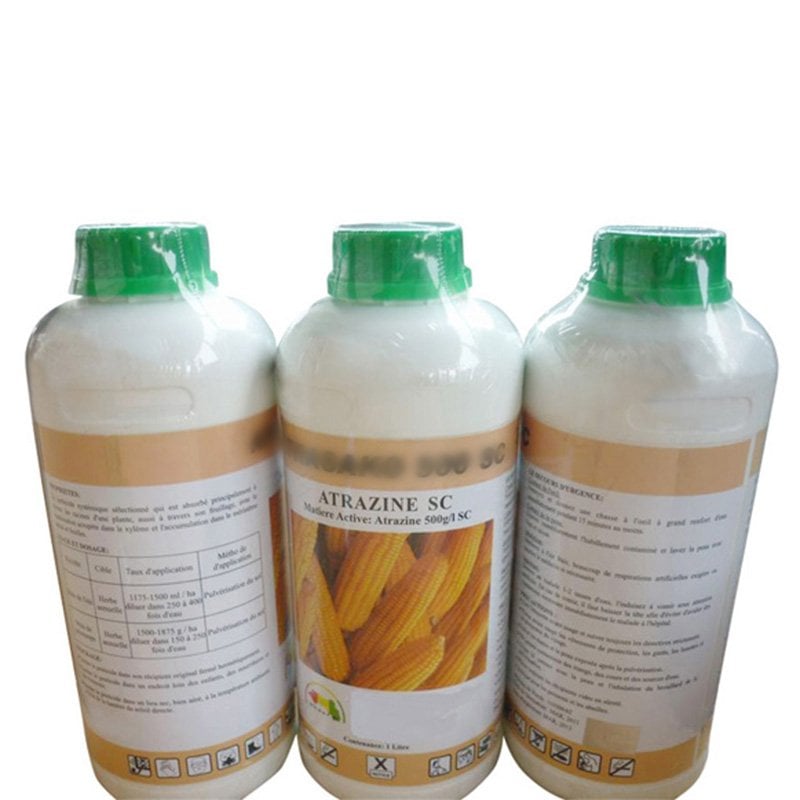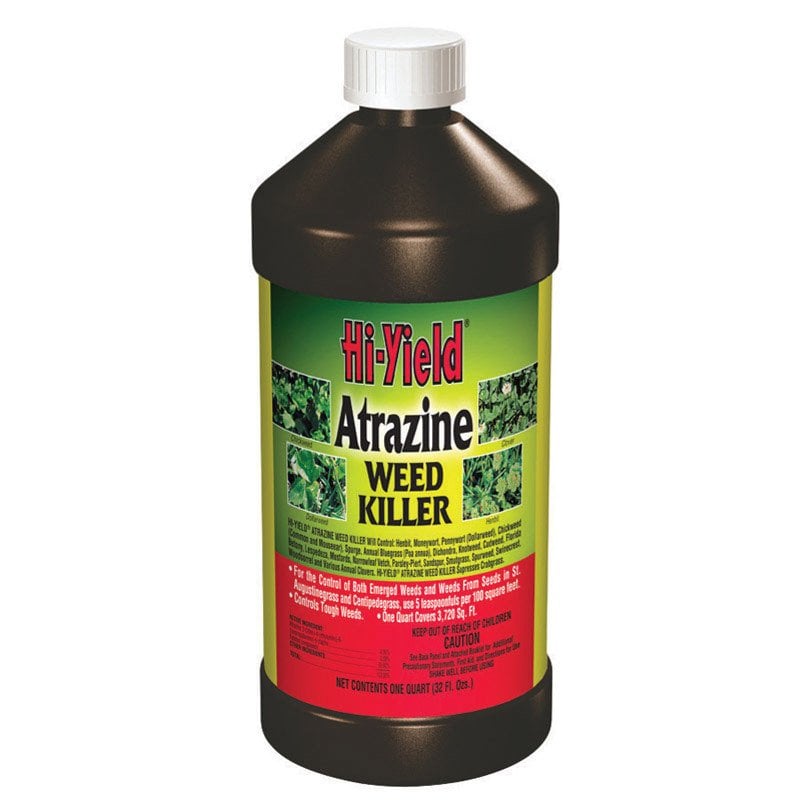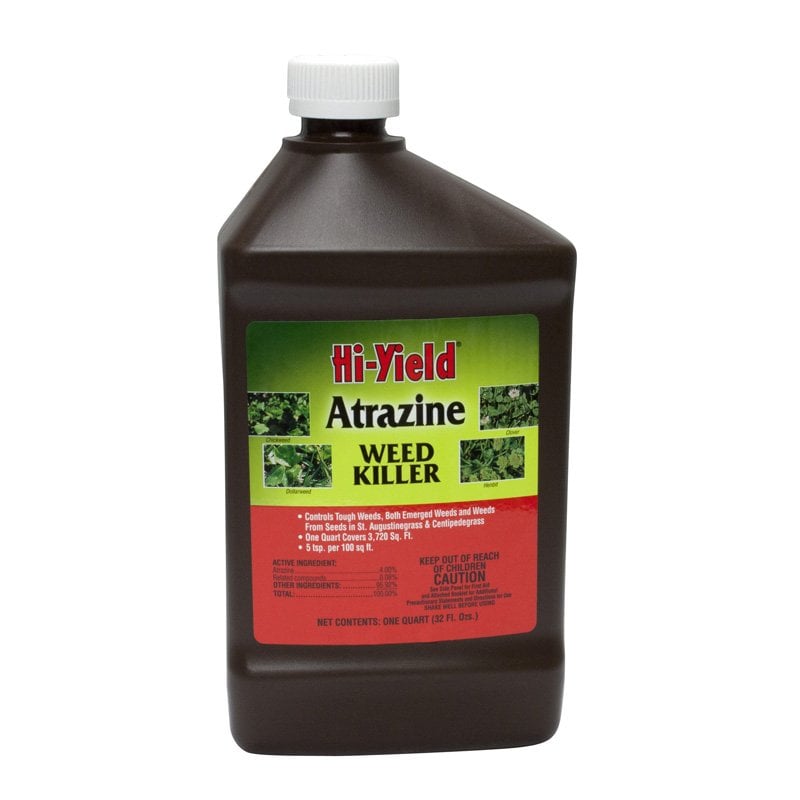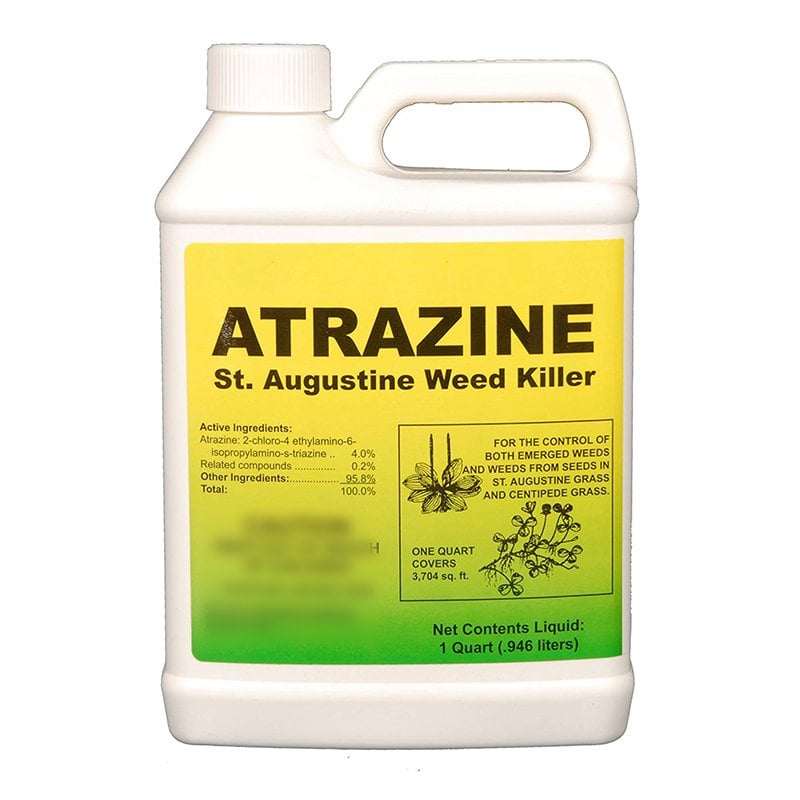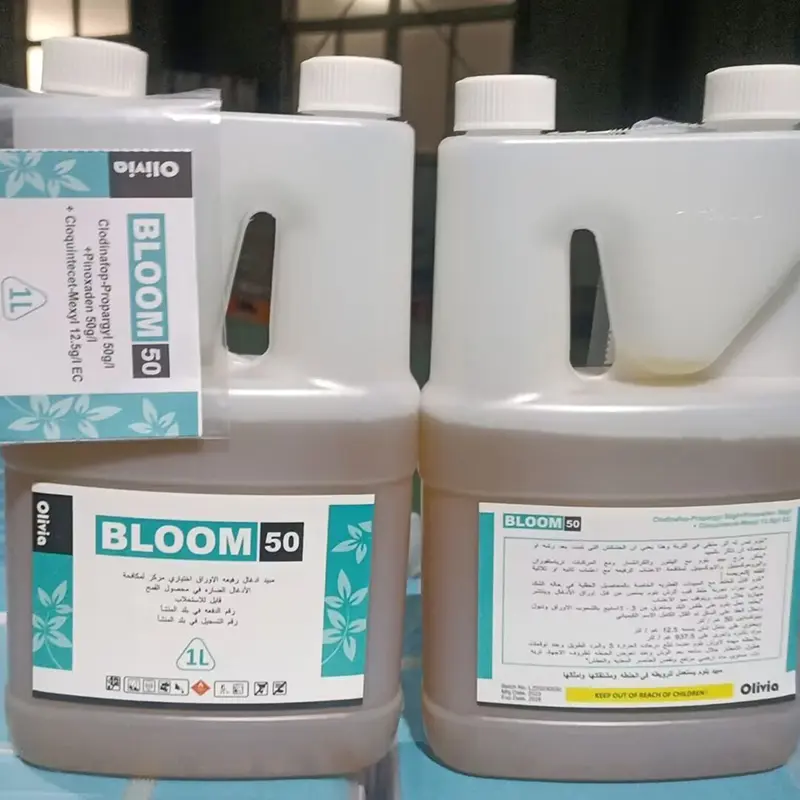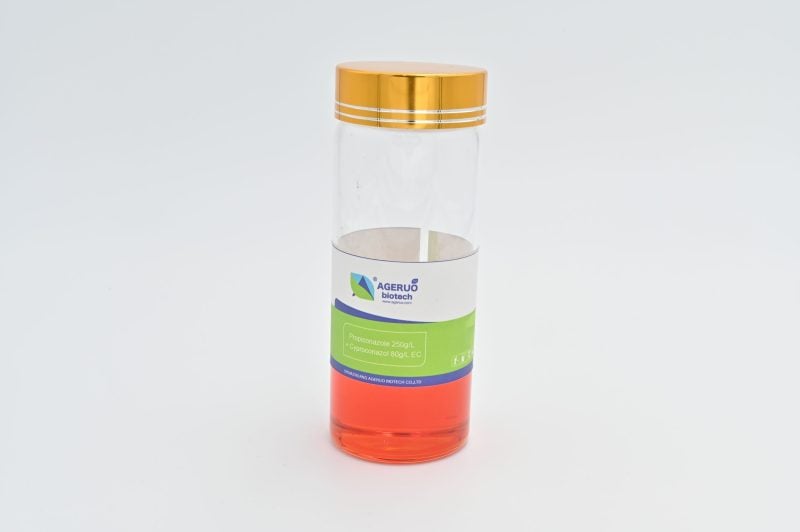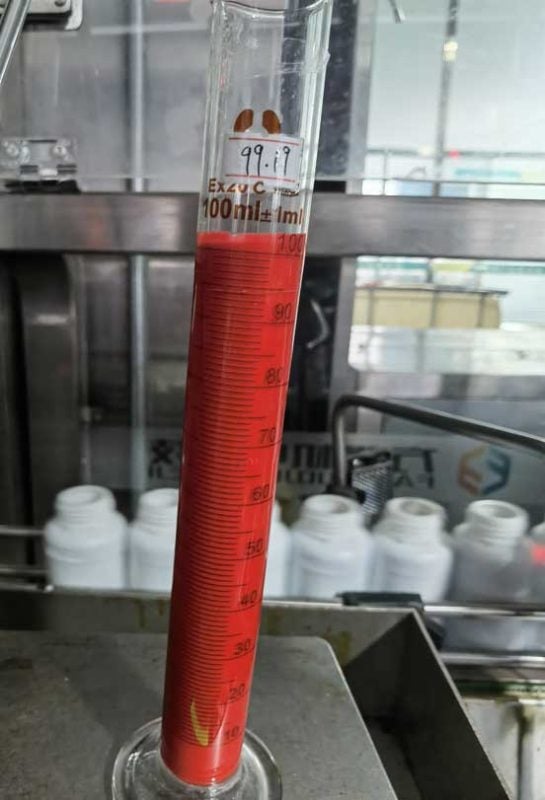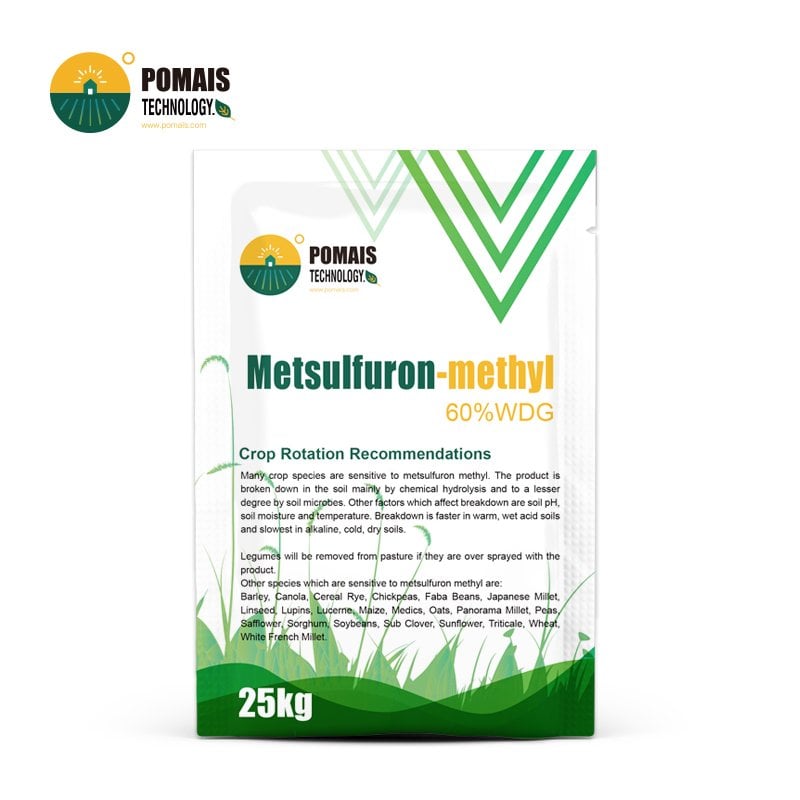Atrazine Weed Killer | Spurge Killer | Atrazine Herbicide for Lawns
Selective Broadleaf & Grass Weed Control for Agriculture and Turf
Atrazine is a selective, broad-spectrum herbicide widely used to control annual broadleaf weeds and grassy species across both large-scale agricultural fields and residential lawns. With a proven mode of action that disrupts photosynthesis in susceptible weeds, Atrazine remains a preferred choice among professional growers, turf managers, and landscape contractors.
Whether you’re targeting stubborn weeds like spurge, crabgrass, foxtail, or pigweed, Atrazine offers reliable performance as both a pre-emergent and post-emergent solution. It is especially effective in corn, sugarcane, and sorghum production systems, as well as in warm-season grasses such as St. Augustine and centipede grass commonly found in southern residential lawns.
At POMAIS, we manufacture a full range of Atrazine-based herbicide formulations with packaging options tailored for bulk distribution and regional market preferences. From ISO-compliant production processes to OEM-ready services, our solutions support your brand’s growth with effective weed control that meets regulatory and performance expectations.
- Designed for Professional Buyers & Bulk Orders
- This product is available for business purchase and large-scale distribution.
- We support custom packaging, labeling, and formulation to meet your market needs.
- Let’s build your brand together.

About Atrazine Weed Killer | Spurge Killer | Atrazine Herbicide for Lawns
About Atrazine Weed Killer | Spurge Killer | Atrazine Herbicide for Lawns
| Product Name | Atrazine (herbicide/weed killer) |
|---|---|
| Active Ingredient | Atrazine |
| CAS Number | 1912-24-9 |
| Molecular Formula | C8H14ClN5 |
| Target Weeds | Broadleaf weeds and grasses such as spurge, crabgrass, and foxtail |
| Applicable Uses | Lawns, cornfields, sorghum, sugarcane, and non-crop areas |
| Dosage | Typically 1-2 quarts per acre for post-emergent applications |
| Mode of Action | Inhibits photosynthesis in targeted weeds, leading to death |
| Common Formulations | 50%SC,80%WDG,50%WP,80%WP |
| Packaging Types | 1L, 5L, 20L containers |
| Related Terms | Atrazine Weed Killer, Spurge Killer, Atrazine Herbicide for Lawns |
| Company Strengths | POMAIS provides high-quality Atrazine formulations for both agricultural and lawn care use, supports OEM/ODM services, and offers custom packaging and labeling solutions |
Atrazine is a powerful solution for controlling a wide range of broadleaf weeds and grasses in corn, sorghum, sugarcane, and lawns. It is particularly effective for controlling spurge, dandelions, and other stubborn weeds. Atrazine is available in various formulations and packaging options to suit different agricultural and residential needs.
We manufacture high-quality Atrazine herbicide with customizable packaging and label design services. Our production processes follow ISO 9001 standards, ensuring product consistency and safety.
Atrazine Herbicide
Atrazine is a widely used herbicide essential for controlling broadleaf and grassy weeds in a variety of crops, including maize, sorghum, and sugarcane. Herbicides like Atrazine play a crucial role in modern agriculture by protecting crops from invasive weeds, thus ensuring higher yields and better-quality produce. As a leader in the agricultural chemical industry, Pomais offers a range of high-quality Atrazine formulations designed to meet the diverse needs of farmers worldwide.
Hot Sale Formulations of Atrazine
Pomais provides several popular Atrazine formulations that cater to different agricultural requirements. These include:
- Atrazine 50% SC (Suspension Concentrate)
- Atrazine 50% WP (Wettable Powder)
- Atrazine 80% WP
- Atrazine 80% WDG (Water-Dispersible Granules)
Each of these formulations offers distinct advantages depending on the specific crop and environmental conditions, ensuring optimal weed control.
Mixed Formulations of Atrazine
In addition to pure Atrazine products, Pomais also produces mixed formulations that combine Atrazine with other active ingredients for enhanced efficacy:
- Atrazine 50% + Mesotrione 5% SC: Effective against a broader spectrum of weeds.
- Atrazine 14% + Propisochlor 26% SE: Provides residual control over longer periods.
- Atrazine 84% + Nicosulfuron 8% WDG: Ideal for post-emergent weed control in maize.
These combinations are tailored to address specific weed challenges and crop needs, offering farmers versatile solutions.
What Is Atrazine and How Does It Control Weeds?
Atrazine is a synthetic herbicide belonging to the triazine chemical class. It works by selectively targeting and disabling photosynthesis in susceptible plant species, particularly annual broadleaf weeds and certain grasses. Once absorbed through the foliage or root system, Atrazine inhibits the electron transport in the chloroplasts, which blocks the plant’s ability to produce essential energy—eventually leading to starvation and death of the weed.
This herbicidal mode of action makes Atrazine an effective pre-emergent solution—applied to the soil before weed seeds germinate—and also useful as a post-emergent herbicide when sprayed directly on young weeds. Its systemic absorption ensures long-lasting residual control, especially in crops like corn, sorghum, and sugarcane, as well as in well-established turf areas.
Unlike non-selective herbicides that damage all plants, Atrazine is designed for selective control, allowing the crop or turf to thrive while suppressing competing weeds. This makes it ideal for integrated weed management (IWM) programs where maximizing yield and minimizing herbicide resistance are critical.
Atrazine Formulations and Concentration Options
Atrazine herbicide is available in a range of formulation types and concentrations to accommodate diverse agricultural and turf management needs. Each formulation offers specific advantages in terms of solubility, application method, and field stability, allowing you to select the most effective solution for your operational environment.
Common Atrazine Formulations:
- Atrazine 50% SC (Suspension Concentrate):
Offers excellent dispersion in water, ideal for foliar application via sprayers in field crops such as corn and sugarcane. - Atrazine 50% WP (Wettable Powder):
A cost-effective option for large-scale weed control programs; requires thorough mixing but provides strong residual control. - Atrazine 80% WP / 80% WDG (Water-Dispersible Granules):
Designed for ease of transport, handling, and application, these high-content dry formulations are preferred in markets requiring longer shelf life and minimal storage risk.
Customized Mixed Formulations:
To expand weed spectrum control and offer synergistic effects, Atrazine is often formulated with complementary herbicidal active ingredients:
- Atrazine 50% + Mesotrione 5% SC – Enhanced efficacy against resistant broadleaf weeds.
- Atrazine 14% + Propisochlor 26% SE – Provides longer-lasting residual control, especially in row crops.
- Atrazine 84% + Nicosulfuron 8% WDG – Excellent for post-emergent applications in maize and cereals.
These mixtures not only reduce application frequency but also help mitigate resistance development by combining different modes of action.
OEM and Bulk Formulation Services:
At POMAIS, we support full customization of Atrazine products, including:
- Active ingredient concentration adjustments
- Formulation type (SC, WP, WDG, SE)
- Label language and regulatory adaptation
- Packaging sizes (500g to 25kg bulk packs)
Whether you’re targeting professional agricultural markets or residential lawn care applications, we can develop a formulation that aligns with your technical, regulatory, and commercial goals.
Target Crops and Weed Spectrum of Atrazine
Atrazine herbicide is trusted across both agricultural and turf management sectors due to its broad-spectrum efficacy against annual broadleaf and grassy weeds. Its mode of action—photosynthesis inhibition—makes it particularly effective for early-season weed suppression, helping you achieve optimal yield potential and maintain a clean field throughout the growing cycle.
Applicable Crops:
Atrazine is commonly applied to the following crops and managed areas:
- Corn (Maize): Highly effective pre- and post-emergent control of key weeds including pigweed, foxtail, and lambsquarters. Often used alone or in tank mixes to enhance spectrum control.
- Sorghum: Provides excellent protection against annual grasses and broadleaf weeds during early development.
- Sugarcane: Helps maintain weed-free conditions during the establishment phase, especially targeting crabgrass and smartweed.
- Turf & Lawns: Ideal for St. Augustine grass, centipedegrass, and other tolerant turf species. Controls tough lawn weeds such as spurge, dandelions, and chickweed.
- Non-Crop Areas: Used in roadside maintenance, fence lines, and industrial zones to eliminate persistent weed growth like foxtail and marestail.
Target Weeds Controlled:
Atrazine effectively controls many common and problematic weeds, including:
- Broadleaf Weeds: Spurge, pigweed, chickweed, dandelion, lambsquarters, marestail, smartweed
- Annual Grasses: Foxtail, crabgrass, barnyard grass, wild oats
For optimal results, Atrazine should be applied when target weeds are young and actively growing. It is especially effective in combination with complementary herbicides for managing herbicide-resistant or hard-to-kill species.
Application Methods & Best Practices
How to Use Atrazine Herbicide Effectively
To ensure optimal weed control and crop safety, Atrazine must be applied with proper timing, dosage, and equipment suited to your specific crop and environmental conditions. Below are best practices developed from field-proven applications:
Application Timing:
- Pre-Emergent Use: Apply Atrazine before weed emergence or at early seedling stages to suppress germination and establishment. Especially effective in corn, sorghum, and lawns.
- Post-Emergent Use: Apply when weeds are no more than 10 cm tall. Ensure crops such as corn are already well-established (above 30 cm in height) to avoid crop injury.
Spray Volume & Coverage:
- Use a ground sprayer with uniform nozzle distribution.
- Dilute Atrazine using 750–1000 L of water per hectare to achieve even soil coverage.
- Avoid overlapping or skipping rows during application.
Incorporation into Soil:
- In dry conditions (7–15 days post-application), a shallow rotary cultivation can help incorporate the herbicide into the topsoil, improving activation and performance.
Recommended Rates by Crop:
| Crop / Area | Application Rate | Target Weeds | Timing |
|---|---|---|---|
| Corn & Sorghum | 2–4 L/ha | Pigweed, Foxtail, Lambsquarters | Pre/post-emergent |
| Sugarcane | 3–5 L/ha | Crabgrass, Smartweed, Annual Broadleafs | Early post-emergent |
| Residential Lawns | 2–3 L/ha | Spurge, Dandelions, Chickweed | Pre/post-emergent |
| Non-Crop Areas | 3–6 L/ha | Foxtail, Marestail, Wild Oats | Spot or broadcast spray |
Always refer to local regulations and product labeling for region-specific restrictions and safety guidance.
Available Formulations of Atrazine Herbicide
Atrazine is formulated in multiple forms to suit different crop systems, environmental conditions, and application methods. Each formulation offers specific handling, solubility, and residual activity characteristics.
Standalone Formulations:
- Atrazine 50% SC (Suspension Concentrate):
Ideal for easy mixing and consistent spray coverage; widely used in mechanized agricultural spraying systems. - Atrazine 50% WP (Wettable Powder):
Offers longer shelf life and good dispersibility, suitable for both backpack and tractor-mounted sprayers. - Atrazine 80% WP / 80% WDG:
High-concentration options for professional use, especially in areas with heavy weed pressure; WDG improves dispersion and reduces dust during handling.
These formulations are commonly applied in maize, sorghum, sugarcane fields, and turfgrass environments for both pre-emergent and early post-emergent weed control.
Combination Products for Broader Weed Control
To enhance the efficacy and broaden the weed spectrum, Atrazine is often combined with other active ingredients. POMAIS manufactures several high-performance combination formulations, including:
- Atrazine 50% + Mesotrione 5% SC:
Effective against both broadleaf and grassy weeds; recommended for maize fields with mixed weed pressure. - Atrazine 14% + Propisochlor 26% SE:
Offers excellent residual control of annual grasses and broadleaf weeds; ideal for sugarcane and corn. - Atrazine 84% + Nicosulfuron 8% WDG:
Designed for post-emergent control in maize; works well on foxtail, barnyardgrass, and pigweed.
These mixtures are particularly valuable in Integrated Weed Management (IWM) programs and areas where resistance management is critical.
Key Benefits of Atrazine Herbicide
Choosing Atrazine as part of your weed management strategy brings multiple agronomic and operational advantages. Its proven performance, selectivity, and adaptability have made it a staple herbicide across agricultural and turfgrass sectors.
1. Broad-Spectrum Weed Control
Atrazine is highly effective against a wide range of broadleaf weeds and certain grasses, including spurge, pigweed, crabgrass, foxtail, and lambsquarters. Whether you’re managing a maize field or a residential lawn, Atrazine ensures consistent results across varying weed types.
2. Selectivity to Preserve Desired Crops or Turf
Designed to target weeds without harming crops like corn, sorghum, and sugarcane or turfgrasses such as St. Augustine and centipede grass, Atrazine supports healthy crop development and uniform lawn appearance without phytotoxic side effects under recommended use conditions.
3. Residual Soil Activity for Extended Protection
Atrazine offers long-lasting residual control, remaining active in the soil for several weeks post-application. This means fewer follow-up sprays and reduced labor, helping you maintain clean fields and lawns over a longer duration.
4. Flexibility in Timing and Use
Suitable for both pre-emergent and post-emergent applications, Atrazine allows flexible weed control planning. It can be integrated into rotation schedules and tank mixes with other herbicides to strengthen weed resistance management programs.
5. Cost-Effective Solution for Large-Scale Weed Control
With its high efficacy and multi-use applicability, Atrazine delivers strong value across both agricultural and landscaping contexts. Its low cost per treated acre makes it especially suitable for large-area farms, contractors, and municipal turf managers.
Packaging & Storage Guidelines for Atrazine Herbicide
To ensure safe handling and maximum shelf-life, Atrazine herbicide is available in professionally packaged formats tailored for both agricultural and turfcare markets.
Available Packaging Options
We offer a broad range of packaging configurations to suit various distribution and application needs. Common packaging includes:
- Liquid Formulations:
- 500 mL, 1 L, 5 L, 20 L HDPE bottles or jerry cans
- Bulk packaging (200 L drums or IBC totes) available upon request
- Solid Formulations (WP, WDG):
- 100 g, 250 g, 500 g, 1 kg, 5 kg foil bags or fiber drums
- Custom OEM printed bags and private-label designs
All containers are compliant with international transport regulations (UN/DOT/ADR) and support long-distance shipping with tamper-evident seals and inner linings.
Storage Conditions
To maintain product efficacy and safety, Atrazine herbicide should be stored under the following conditions:
- Temperature Range: 0°C to 35°C (32°F to 95°F)
- Environment: Store in a dry, cool, well-ventilated place away from direct sunlight
- Container Requirements: Keep original container tightly sealed and labeled
- Incompatibility: Do not store near food, feed, or flammable materials
When stored under proper conditions, Atrazine maintains stability for a minimum of two years, with no significant degradation in active content.
OEM Services & Supply Capability
As a reliable Atrazine herbicide supplier, POMAIS is committed to providing you not only with high-quality active ingredients and stable formulations, but also with the production flexibility and marketing support needed to grow your business in competitive markets.
OEM & Private Label Solutions
Whether you’re building a new brand or expanding an existing product line, we offer full-service OEM capabilities tailored to your specifications:
- Custom Formulation Support: Adjust the percentage of Atrazine or combine with other actives (e.g. Mesotrione, Propisochlor) to target specific weed spectrums.
- Packaging Customization: From label design to container selection, we offer fully branded retail or bulk packaging options for both agricultural and lawn care markets.
- Language & Compliance Adaptation: Product labels and documentation can be adapted to local regulatory requirements in English, Spanish, Arabic, Russian, French, and more.
- Flexible MOQs: Support both small trial orders and large containerized shipments, ideal for regional distributors and multi-country marketing.
Production Capacity & Supply Reliability
With modern manufacturing facilities and ISO 9001:2015 certified processes, POMAIS ensures consistent quality, timely delivery, and volume scalability:
- Formulation Types Available: SC, WP, WDG, SE
- Monthly Output: Up to 500 tons across all formulations
- Lead Time: Typically 7–15 working days for standard orders
- Global Export Experience: Over 60 countries served with documented registration and customs support
Our logistics team offers support for CIF, FOB, DDP, and EXW terms, ensuring safe and cost-effective delivery tailored to your import model.
Frequently Asked Questions (FAQ)
Q1: What weeds does Atrazine kill?
Atrazine is highly effective against a broad spectrum of broadleaf weeds and certain grasses, including spurge, pigweed, crabgrass, foxtail, lambsquarters, smartweed, chickweed, and dandelions. It’s especially preferred in lawns, corn, sugarcane, and non-crop areas for persistent weed problems.
Q2: Is Atrazine a pre-emergent or post-emergent herbicide?
Atrazine functions as both a pre-emergent and post-emergent herbicide. It works best when applied before weeds germinate but also controls young, actively growing weeds when applied post-emergence.
Q3: How long does Atrazine remain active in the soil?
Atrazine typically remains active for 4–8 weeks, depending on soil type, application rate, and rainfall. This provides long residual control, suppressing the growth of new weeds during this period.
Q4: Can Atrazine be used on Bermuda grass or St. Augustine lawns?
Yes, Atrazine is widely used on St. Augustine and Centipede lawns, and it can also be applied to Bermuda grass under certain conditions. Always follow the product label instructions, as turfgrass tolerance varies based on variety and climate.
Q5: Is it safe to plant new crops after using Atrazine?
Crop rotation after using Atrazine requires caution. Some sensitive crops like lettuce, carrots, or beans may be injured if planted too soon after application. Refer to your local extension guidelines and allow adequate plant-back intervals, typically 12–18 months for sensitive crops.
Q6: Can Atrazine be mixed with other herbicides?
Yes, Atrazine is commonly tank-mixed with herbicides like glyphosate, simazine, or mesotrione to broaden weed control spectrum. Always perform a jar test before large-scale mixing and follow compatibility guidelines.
Q7: What is the recommended application rate for Atrazine 4L?
For Atrazine 4L liquid formulation, the standard rate is 1–2 quarts per acre for most post-emergent applications in corn or turf. This may vary based on weed type, growth stage, and local regulations.
Partner with POMAIS for Premium Atrazine Solutions
Whether you’re supplying herbicides for large-scale agriculture, residential lawn care, or municipal vegetation control, POMAIS is ready to support your business with high-quality Atrazine formulations, competitive pricing, and reliable delivery.
We offer:
- A full range of Atrazine concentrations and combinations, including 50% SC, 80% WP, and custom mixes
- OEM/ODM services, including private label, registration dossier assistance, and packaging customization
- Compliance with ISO 9001 and agrochemical regulations across major export markets
With years of expertise in serving importers, brand owners, and regional distributors, we understand the importance of formulation stability, regulatory support, and logistics efficiency. Let us help you develop herbicide products that perform consistently in your local market.
Ready to source Atrazine herbicide that delivers results?
Contact us now to request a sample, get technical specifications, or receive a personalized quotation tailored to your market.
| Product Name | Atrazine (herbicide/weed killer) |
|---|---|
| Active Ingredient | Atrazine |
| CAS Number | 1912-24-9 |
| Molecular Formula | C8H14ClN5 |
| Target Weeds | Broadleaf weeds and grasses such as spurge, crabgrass, and foxtail |
| Applicable Uses | Lawns, cornfields, sorghum, sugarcane, and non-crop areas |
| Dosage | Typically 1-2 quarts per acre for post-emergent applications |
| Mode of Action | Inhibits photosynthesis in targeted weeds, leading to death |
| Common Formulations | 50%SC,80%WDG,50%WP,80%WP |
| Packaging Types | 1L, 5L, 20L containers |
| Related Terms | Atrazine Weed Killer, Spurge Killer, Atrazine Herbicide for Lawns |
| Company Strengths | POMAIS provides high-quality Atrazine formulations for both agricultural and lawn care use, supports OEM/ODM services, and offers custom packaging and labeling solutions |
Atrazine is a powerful solution for controlling a wide range of broadleaf weeds and grasses in corn, sorghum, sugarcane, and lawns. It is particularly effective for controlling spurge, dandelions, and other stubborn weeds. Atrazine is available in various formulations and packaging options to suit different agricultural and residential needs.
We manufacture high-quality Atrazine herbicide with customizable packaging and label design services. Our production processes follow ISO 9001 standards, ensuring product consistency and safety.
Atrazine Herbicide
Atrazine is a widely used herbicide essential for controlling broadleaf and grassy weeds in a variety of crops, including maize, sorghum, and sugarcane. Herbicides like Atrazine play a crucial role in modern agriculture by protecting crops from invasive weeds, thus ensuring higher yields and better-quality produce. As a leader in the agricultural chemical industry, Pomais offers a range of high-quality Atrazine formulations designed to meet the diverse needs of farmers worldwide.
Hot Sale Formulations of Atrazine
Pomais provides several popular Atrazine formulations that cater to different agricultural requirements. These include:
- Atrazine 50% SC (Suspension Concentrate)
- Atrazine 50% WP (Wettable Powder)
- Atrazine 80% WP
- Atrazine 80% WDG (Water-Dispersible Granules)
Each of these formulations offers distinct advantages depending on the specific crop and environmental conditions, ensuring optimal weed control.
Mixed Formulations of Atrazine
In addition to pure Atrazine products, Pomais also produces mixed formulations that combine Atrazine with other active ingredients for enhanced efficacy:
- Atrazine 50% + Mesotrione 5% SC: Effective against a broader spectrum of weeds.
- Atrazine 14% + Propisochlor 26% SE: Provides residual control over longer periods.
- Atrazine 84% + Nicosulfuron 8% WDG: Ideal for post-emergent weed control in maize.
These combinations are tailored to address specific weed challenges and crop needs, offering farmers versatile solutions.
What Is Atrazine and How Does It Control Weeds?
Atrazine is a synthetic herbicide belonging to the triazine chemical class. It works by selectively targeting and disabling photosynthesis in susceptible plant species, particularly annual broadleaf weeds and certain grasses. Once absorbed through the foliage or root system, Atrazine inhibits the electron transport in the chloroplasts, which blocks the plant’s ability to produce essential energy—eventually leading to starvation and death of the weed.
This herbicidal mode of action makes Atrazine an effective pre-emergent solution—applied to the soil before weed seeds germinate—and also useful as a post-emergent herbicide when sprayed directly on young weeds. Its systemic absorption ensures long-lasting residual control, especially in crops like corn, sorghum, and sugarcane, as well as in well-established turf areas.
Unlike non-selective herbicides that damage all plants, Atrazine is designed for selective control, allowing the crop or turf to thrive while suppressing competing weeds. This makes it ideal for integrated weed management (IWM) programs where maximizing yield and minimizing herbicide resistance are critical.
Atrazine Formulations and Concentration Options
Atrazine herbicide is available in a range of formulation types and concentrations to accommodate diverse agricultural and turf management needs. Each formulation offers specific advantages in terms of solubility, application method, and field stability, allowing you to select the most effective solution for your operational environment.
Common Atrazine Formulations:
- Atrazine 50% SC (Suspension Concentrate):
Offers excellent dispersion in water, ideal for foliar application via sprayers in field crops such as corn and sugarcane. - Atrazine 50% WP (Wettable Powder):
A cost-effective option for large-scale weed control programs; requires thorough mixing but provides strong residual control. - Atrazine 80% WP / 80% WDG (Water-Dispersible Granules):
Designed for ease of transport, handling, and application, these high-content dry formulations are preferred in markets requiring longer shelf life and minimal storage risk.
Customized Mixed Formulations:
To expand weed spectrum control and offer synergistic effects, Atrazine is often formulated with complementary herbicidal active ingredients:
- Atrazine 50% + Mesotrione 5% SC – Enhanced efficacy against resistant broadleaf weeds.
- Atrazine 14% + Propisochlor 26% SE – Provides longer-lasting residual control, especially in row crops.
- Atrazine 84% + Nicosulfuron 8% WDG – Excellent for post-emergent applications in maize and cereals.
These mixtures not only reduce application frequency but also help mitigate resistance development by combining different modes of action.
OEM and Bulk Formulation Services:
At POMAIS, we support full customization of Atrazine products, including:
- Active ingredient concentration adjustments
- Formulation type (SC, WP, WDG, SE)
- Label language and regulatory adaptation
- Packaging sizes (500g to 25kg bulk packs)
Whether you’re targeting professional agricultural markets or residential lawn care applications, we can develop a formulation that aligns with your technical, regulatory, and commercial goals.
Target Crops and Weed Spectrum of Atrazine
Atrazine herbicide is trusted across both agricultural and turf management sectors due to its broad-spectrum efficacy against annual broadleaf and grassy weeds. Its mode of action—photosynthesis inhibition—makes it particularly effective for early-season weed suppression, helping you achieve optimal yield potential and maintain a clean field throughout the growing cycle.
Applicable Crops:
Atrazine is commonly applied to the following crops and managed areas:
- Corn (Maize): Highly effective pre- and post-emergent control of key weeds including pigweed, foxtail, and lambsquarters. Often used alone or in tank mixes to enhance spectrum control.
- Sorghum: Provides excellent protection against annual grasses and broadleaf weeds during early development.
- Sugarcane: Helps maintain weed-free conditions during the establishment phase, especially targeting crabgrass and smartweed.
- Turf & Lawns: Ideal for St. Augustine grass, centipedegrass, and other tolerant turf species. Controls tough lawn weeds such as spurge, dandelions, and chickweed.
- Non-Crop Areas: Used in roadside maintenance, fence lines, and industrial zones to eliminate persistent weed growth like foxtail and marestail.
Target Weeds Controlled:
Atrazine effectively controls many common and problematic weeds, including:
- Broadleaf Weeds: Spurge, pigweed, chickweed, dandelion, lambsquarters, marestail, smartweed
- Annual Grasses: Foxtail, crabgrass, barnyard grass, wild oats
For optimal results, Atrazine should be applied when target weeds are young and actively growing. It is especially effective in combination with complementary herbicides for managing herbicide-resistant or hard-to-kill species.
Application Methods & Best Practices
How to Use Atrazine Herbicide Effectively
To ensure optimal weed control and crop safety, Atrazine must be applied with proper timing, dosage, and equipment suited to your specific crop and environmental conditions. Below are best practices developed from field-proven applications:
Application Timing:
- Pre-Emergent Use: Apply Atrazine before weed emergence or at early seedling stages to suppress germination and establishment. Especially effective in corn, sorghum, and lawns.
- Post-Emergent Use: Apply when weeds are no more than 10 cm tall. Ensure crops such as corn are already well-established (above 30 cm in height) to avoid crop injury.
Spray Volume & Coverage:
- Use a ground sprayer with uniform nozzle distribution.
- Dilute Atrazine using 750–1000 L of water per hectare to achieve even soil coverage.
- Avoid overlapping or skipping rows during application.
Incorporation into Soil:
- In dry conditions (7–15 days post-application), a shallow rotary cultivation can help incorporate the herbicide into the topsoil, improving activation and performance.
Recommended Rates by Crop:
| Crop / Area | Application Rate | Target Weeds | Timing |
|---|---|---|---|
| Corn & Sorghum | 2–4 L/ha | Pigweed, Foxtail, Lambsquarters | Pre/post-emergent |
| Sugarcane | 3–5 L/ha | Crabgrass, Smartweed, Annual Broadleafs | Early post-emergent |
| Residential Lawns | 2–3 L/ha | Spurge, Dandelions, Chickweed | Pre/post-emergent |
| Non-Crop Areas | 3–6 L/ha | Foxtail, Marestail, Wild Oats | Spot or broadcast spray |
Always refer to local regulations and product labeling for region-specific restrictions and safety guidance.
Available Formulations of Atrazine Herbicide
Atrazine is formulated in multiple forms to suit different crop systems, environmental conditions, and application methods. Each formulation offers specific handling, solubility, and residual activity characteristics.
Standalone Formulations:
- Atrazine 50% SC (Suspension Concentrate):
Ideal for easy mixing and consistent spray coverage; widely used in mechanized agricultural spraying systems. - Atrazine 50% WP (Wettable Powder):
Offers longer shelf life and good dispersibility, suitable for both backpack and tractor-mounted sprayers. - Atrazine 80% WP / 80% WDG:
High-concentration options for professional use, especially in areas with heavy weed pressure; WDG improves dispersion and reduces dust during handling.
These formulations are commonly applied in maize, sorghum, sugarcane fields, and turfgrass environments for both pre-emergent and early post-emergent weed control.
Combination Products for Broader Weed Control
To enhance the efficacy and broaden the weed spectrum, Atrazine is often combined with other active ingredients. POMAIS manufactures several high-performance combination formulations, including:
- Atrazine 50% + Mesotrione 5% SC:
Effective against both broadleaf and grassy weeds; recommended for maize fields with mixed weed pressure. - Atrazine 14% + Propisochlor 26% SE:
Offers excellent residual control of annual grasses and broadleaf weeds; ideal for sugarcane and corn. - Atrazine 84% + Nicosulfuron 8% WDG:
Designed for post-emergent control in maize; works well on foxtail, barnyardgrass, and pigweed.
These mixtures are particularly valuable in Integrated Weed Management (IWM) programs and areas where resistance management is critical.
Key Benefits of Atrazine Herbicide
Choosing Atrazine as part of your weed management strategy brings multiple agronomic and operational advantages. Its proven performance, selectivity, and adaptability have made it a staple herbicide across agricultural and turfgrass sectors.
1. Broad-Spectrum Weed Control
Atrazine is highly effective against a wide range of broadleaf weeds and certain grasses, including spurge, pigweed, crabgrass, foxtail, and lambsquarters. Whether you’re managing a maize field or a residential lawn, Atrazine ensures consistent results across varying weed types.
2. Selectivity to Preserve Desired Crops or Turf
Designed to target weeds without harming crops like corn, sorghum, and sugarcane or turfgrasses such as St. Augustine and centipede grass, Atrazine supports healthy crop development and uniform lawn appearance without phytotoxic side effects under recommended use conditions.
3. Residual Soil Activity for Extended Protection
Atrazine offers long-lasting residual control, remaining active in the soil for several weeks post-application. This means fewer follow-up sprays and reduced labor, helping you maintain clean fields and lawns over a longer duration.
4. Flexibility in Timing and Use
Suitable for both pre-emergent and post-emergent applications, Atrazine allows flexible weed control planning. It can be integrated into rotation schedules and tank mixes with other herbicides to strengthen weed resistance management programs.
5. Cost-Effective Solution for Large-Scale Weed Control
With its high efficacy and multi-use applicability, Atrazine delivers strong value across both agricultural and landscaping contexts. Its low cost per treated acre makes it especially suitable for large-area farms, contractors, and municipal turf managers.
Packaging & Storage Guidelines for Atrazine Herbicide
To ensure safe handling and maximum shelf-life, Atrazine herbicide is available in professionally packaged formats tailored for both agricultural and turfcare markets.
Available Packaging Options
We offer a broad range of packaging configurations to suit various distribution and application needs. Common packaging includes:
- Liquid Formulations:
- 500 mL, 1 L, 5 L, 20 L HDPE bottles or jerry cans
- Bulk packaging (200 L drums or IBC totes) available upon request
- Solid Formulations (WP, WDG):
- 100 g, 250 g, 500 g, 1 kg, 5 kg foil bags or fiber drums
- Custom OEM printed bags and private-label designs
All containers are compliant with international transport regulations (UN/DOT/ADR) and support long-distance shipping with tamper-evident seals and inner linings.
Storage Conditions
To maintain product efficacy and safety, Atrazine herbicide should be stored under the following conditions:
- Temperature Range: 0°C to 35°C (32°F to 95°F)
- Environment: Store in a dry, cool, well-ventilated place away from direct sunlight
- Container Requirements: Keep original container tightly sealed and labeled
- Incompatibility: Do not store near food, feed, or flammable materials
When stored under proper conditions, Atrazine maintains stability for a minimum of two years, with no significant degradation in active content.
OEM Services & Supply Capability
As a reliable Atrazine herbicide supplier, POMAIS is committed to providing you not only with high-quality active ingredients and stable formulations, but also with the production flexibility and marketing support needed to grow your business in competitive markets.
OEM & Private Label Solutions
Whether you’re building a new brand or expanding an existing product line, we offer full-service OEM capabilities tailored to your specifications:
- Custom Formulation Support: Adjust the percentage of Atrazine or combine with other actives (e.g. Mesotrione, Propisochlor) to target specific weed spectrums.
- Packaging Customization: From label design to container selection, we offer fully branded retail or bulk packaging options for both agricultural and lawn care markets.
- Language & Compliance Adaptation: Product labels and documentation can be adapted to local regulatory requirements in English, Spanish, Arabic, Russian, French, and more.
- Flexible MOQs: Support both small trial orders and large containerized shipments, ideal for regional distributors and multi-country marketing.
Production Capacity & Supply Reliability
With modern manufacturing facilities and ISO 9001:2015 certified processes, POMAIS ensures consistent quality, timely delivery, and volume scalability:
- Formulation Types Available: SC, WP, WDG, SE
- Monthly Output: Up to 500 tons across all formulations
- Lead Time: Typically 7–15 working days for standard orders
- Global Export Experience: Over 60 countries served with documented registration and customs support
Our logistics team offers support for CIF, FOB, DDP, and EXW terms, ensuring safe and cost-effective delivery tailored to your import model.
Frequently Asked Questions (FAQ)
Q1: What weeds does Atrazine kill?
Atrazine is highly effective against a broad spectrum of broadleaf weeds and certain grasses, including spurge, pigweed, crabgrass, foxtail, lambsquarters, smartweed, chickweed, and dandelions. It’s especially preferred in lawns, corn, sugarcane, and non-crop areas for persistent weed problems.
Q2: Is Atrazine a pre-emergent or post-emergent herbicide?
Atrazine functions as both a pre-emergent and post-emergent herbicide. It works best when applied before weeds germinate but also controls young, actively growing weeds when applied post-emergence.
Q3: How long does Atrazine remain active in the soil?
Atrazine typically remains active for 4–8 weeks, depending on soil type, application rate, and rainfall. This provides long residual control, suppressing the growth of new weeds during this period.
Q4: Can Atrazine be used on Bermuda grass or St. Augustine lawns?
Yes, Atrazine is widely used on St. Augustine and Centipede lawns, and it can also be applied to Bermuda grass under certain conditions. Always follow the product label instructions, as turfgrass tolerance varies based on variety and climate.
Q5: Is it safe to plant new crops after using Atrazine?
Crop rotation after using Atrazine requires caution. Some sensitive crops like lettuce, carrots, or beans may be injured if planted too soon after application. Refer to your local extension guidelines and allow adequate plant-back intervals, typically 12–18 months for sensitive crops.
Q6: Can Atrazine be mixed with other herbicides?
Yes, Atrazine is commonly tank-mixed with herbicides like glyphosate, simazine, or mesotrione to broaden weed control spectrum. Always perform a jar test before large-scale mixing and follow compatibility guidelines.
Q7: What is the recommended application rate for Atrazine 4L?
For Atrazine 4L liquid formulation, the standard rate is 1–2 quarts per acre for most post-emergent applications in corn or turf. This may vary based on weed type, growth stage, and local regulations.
Partner with POMAIS for Premium Atrazine Solutions
Whether you’re supplying herbicides for large-scale agriculture, residential lawn care, or municipal vegetation control, POMAIS is ready to support your business with high-quality Atrazine formulations, competitive pricing, and reliable delivery.
We offer:
- A full range of Atrazine concentrations and combinations, including 50% SC, 80% WP, and custom mixes
- OEM/ODM services, including private label, registration dossier assistance, and packaging customization
- Compliance with ISO 9001 and agrochemical regulations across major export markets
With years of expertise in serving importers, brand owners, and regional distributors, we understand the importance of formulation stability, regulatory support, and logistics efficiency. Let us help you develop herbicide products that perform consistently in your local market.
Ready to source Atrazine herbicide that delivers results?
Contact us now to request a sample, get technical specifications, or receive a personalized quotation tailored to your market.
Related Products
Latest News



